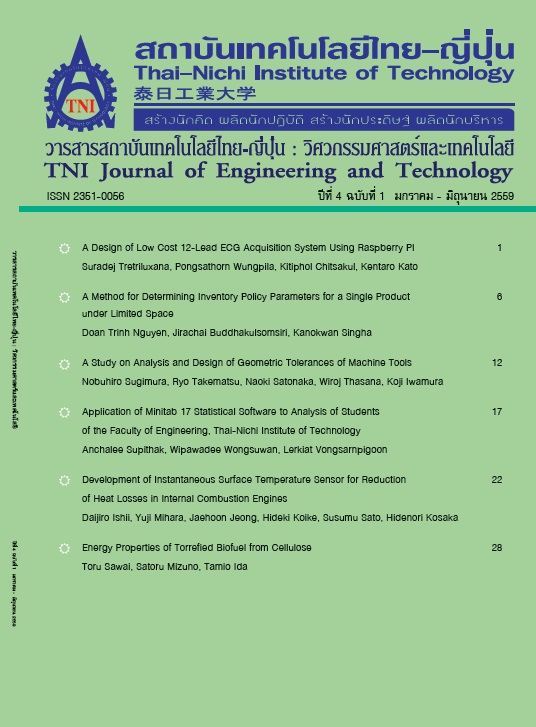A Method for Determining Inventory Policy Parameters for a Single Product under Limited Space
Main Article Content
Abstract
This study involves a method for determining parameters for a (R, Q) inventory policy for a single product under limited storage space. Most previous research developed
methods for finding optimal reorder point (R) and order quantity (Q) that minimizes total cost including holding cost, ordering cost and shortage cost. This study incorporates limitation of storage space by adding the cost of overstocking to the total cost. A method to find appropriate values of these parameters is proposed for the case where a single product is subject to uncertain demand and lead time limited storage space capacity. A numerical example based on real product data is used to demonstrate effectiveness of the method.
Article Details
Article Accepting Policy
The editorial board of Thai-Nichi Institute of Technology is pleased to receive articles from lecturers and experts in the fields of engineering and technology written in Thai or English. The academic work submitted for publication must not be published in any other publication before and must not be under consideration of other journal submissions. Therefore, those interested in participating in the dissemination of work and knowledge can submit their article to the editorial board for further submission to the screening committee to consider publishing in the journal. The articles that can be published include solely research articles. Interested persons can prepare their articles by reviewing recommendations for article authors.
Copyright infringement is solely the responsibility of the author(s) of the article. Articles that have been published must be screened and reviewed for quality from qualified experts approved by the editorial board.
The text that appears within each article published in this research journal is a personal opinion of each author, nothing related to Thai-Nichi Institute of Technology, and other faculty members in the institution in any way. Responsibilities and accuracy for the content of each article are owned by each author. If there is any mistake, each author will be responsible for his/her own article(s).
The editorial board reserves the right not to bring any content, views or comments of articles in the Journal of Thai-Nichi Institute of Technology to publish before receiving permission from the authorized author(s) in writing. The published work is the copyright of the Journal of Thai-Nichi Institute of Technology.
References
M. A. Hariga, “A single-item continuous review inventory problem with space restriction,” International Journal of Production Economics,vol. 128, no. 1, pp. 153-158, Nov. 2010.
M. Hariga, “A continuous review (Q, r) model with owned and rented storage facilities,” in International Conference on Computers Industrial Engineering, 2009. CIE 2009, 2009, pp. 1297-1301.
X. Zhao, F. Fan, X. Liu, and J. Xie, “Storage-Space Capacitated Inventory System with (r, Q) Policies,” Operations Research, vol.55, no. 5, pp. 854-865, Oct. 2007.
S. S. Sana, “An EOQ model for stochastic demand for limited capacity of own warehouse,” Ann Oper Res, vol. 233, no. 1, pp.383-399, Dec. 2013.
T. K. Roy and M. Maiti, “A fuzzy EOQ model with demand-dependent unit cost under limited storage capacity,” European Journal of Operational Research, vol. 99, no. 2, pp. 425-432, Jun. 1997.
Ö. Özer and W. Wei, “Inventory Control with Limited Capacity and Advance Demand Information,” Operations Research, vol. 52, no.6, pp. 988-1000, Dec. 2004.
S. S. Sana, “An EOQ model for stochastic demand for limited capacity of own warehouse,” Ann Oper Res, vol. 233, no. 1, pp.383-399, Dec. 2013.
M. S. Bazaraa, H. D. Sherali, and C. M. Shetty, Nonlinear Programming: Theory and Algorithms, 2nd ed. Hoboken, New Jersey: Wiley, 1993.
T. Vollmann, W. Berry, D. C. Whybark, and F. R. Jacobs, MANUFACTURING PLANNING AND CONTROL SYSTEMS. New York: McGraw-Hill, 1997.


